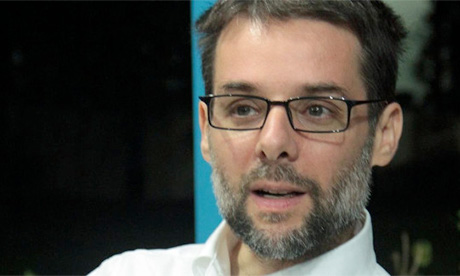Bishop Charles Morerod, who is recognized as one the leading intellectuals among the Catholic hierarchy of Europe, recently told La Croix “the Church reforms itself under the influence of seemingly adverse forces.”
The 57-year-old Swiss Dominican, head of the Diocese of Lausanne-Genève-Fribourg since 2011, was referring to the sexual abuse crisis and how it is putting pressure for change on the Catholic Church.
Mounting pressure is a key factor to consider in the debates within the Church about the institutional reforms that are needed to address how bishops have failed in handling sex abuse cases. But this pressure on the institutional Church is undeniably different today from that of the past.
First, there is pressure from internal debate (within the Church), as well as from external forces (the media, society and culture, the state and the judiciary).
This pressure is more visible and public than in the past. And it is also something much more difficult for the institutional Church to control, not by coercive measures, but in the sense of controlling the narrative.
Mass media and social media have changed the conversation within the Catholic Church, creating deep consequences that are really beyond anyone’s comprehension.
This is where the boundary between internal debate and external forces gets blurred.
Mass media and social media have changed the conversation within the Catholic Church, creating deep consequences that are really beyond anyone’s comprehension.
Second, the internal debate has shown sharp divisions among Catholics in never before public way.
Some Catholics think the debate over ecclesial reform should include a reconsideration of the theology of the priesthood and seminary formation, the role of the laity and of women, and the Church’s teaching on sexuality.
Others have a restorationist and puritan agenda that see homosexuality as the root cause of the current crisis and those who disagree with their call for a gay witch hunt as accomplices.
This tension caused by these polarities is not necessarily bad.
Pope Francis believes polarities are necessary in order to help the truth fully emerge.
The problem is that in some local churches, such as in the United States, the intra-ecclesial debate tends to be more polarized than the pope can probably imagine.
All this makes Bishop Morerod’s point about the need for putting pressure on the Church even more important, especially from an historical perspective.
In the long course of doctrinal development, for example, the heresies played an important role in pushing the Church’s theologians and pastors towards the correct and more complete understanding of God.
Institutional reforms within the Church have mostly been born via negativa; that is, out of a reaction against something.
The Church has rarely changed spontaneously. It has done so almost always because of pressure.
In a similar way, institutional reforms within the Church have mostly been born via negativa; that is, out of a reaction against something.
The Church has rarely changed spontaneously. It has done so almost always because of pressure.
Most of the time that has come from the outside – from political and cultural pressure, repression and persecution, and outrage caused by the revelation of scandal.
Throughout history there has been no change in the Church without at least some external pressure. And the current abuse crisis has sparked enormous external pressure for it to change again.
The problem is that not all change constitutes real reform. For instance, the First Vatican Council (1869-70) modernized papal power without really introducing much in the way of doctrinal reform.
The history of 19th-century Catholicism reminds us of the negative effects external pressure can create in a religious institution that perceives itself as being under siege.
The period of Ultramontanism, between the 1820s and Vatican I, created a political and religious culture in the Church of resistance and reaction against external pressure. Liberalism and modernity were the foils against which it elaborated a new strategy for survival.
In a Church dominated by a “siege mentality,” talk of reform has often sounded like betrayal or even heresy. And, yet, Catholicism of the “long nineteenth century,” which ended in 1958 with the death of Pius XII, was developing its own modernization even as it fought against the forces of secularist, totalitarian modernization, as James Chappel points out in his recent book, Catholic Modern.
However, this was not exactly a moment of institutional reform.
One of the differences in the way pressure works on the Church today, as compared to the past, is that, until recently, “the Catholic Church” was understood more or less to be an entity under tight institutional control.
At least this was true in principle and by perception. It was a natural fit with the siege mentality. On the one hand, this made ecclesial reform much more difficult.
But on the other hand, it also showed clearly the only path through which reform could travel – through the Vatican, the bishops, the clergy and theologians who had the ears of the Church’s decision-makers. That system has now largely disappeared.
The theological rethinking that led to the Second Vatican Council was made possible by ditching a siege mentality, which had reduced the Church to a defensive crouch, triumphalistic in its rhetoric but insecure in its relations with the modern world.
The theological rethinking that led to the Second Vatican Council (1962-65) was made possible by ditching this siege mentality, which had reduced the Church to a defensive crouch, triumphalistic in its rhetoric but insecure in its relations with the modern world.
At Vatican II, the Church opened itself to dialogue with the world and theological and spiritual renewal.
It did so by following two principles: ressourcement (a rediscovery of the sources of the tradition) and aggiornamento (an openness to the resources of modernity).
But that openness to the world had undeniable costs. Clearly Vatican II still belonged to a Church-world pattern of relationship that is now gone. Until a few years ago, it was much harder for an individual Catholic to know what was happening at the other end of the world.
It was also much more difficult for that person to be reached by particular “narratives” and agendas concerning the contemporary Church.
The crisis of clergy sexual abuse has created new tensions and new possibilities. But it has reawakened the temptation towards retrenchment.
Until the end of the 20th century, external pressure created an internal counter-pressure in a Church that was more controlled by the ecclesiastical institution, but also by the social and cultural system where it was assumed that the Church could take care of itself.
The institutional Church has since lost its monopoly on reform.
There are many reasons for this. Some are theological but mostly they have to do with the changing role of the Church in a modern, pluralistic world.
Thus it has become disputable whether or not ressourcement and aggiornamento — and of what sort — can still lead the Catholic Church of today on a path toward institutional and theological reform.
That’s because the Church that is going thought the abuse crisis is the very same that was going through the renewal of Vatican II.
The crisis of clergy sexual abuse has created new tensions and new possibilities. But it has reawakened the temptation towards retrenchment.
Pressure from Catholic groups and external forces, neither of which trusts the Church’s ability to police itself, is a sword that could cut both ways – for or against genuine ecclesial reform.
- Massimo Faggioli is a Church historian, Professor of Theology and Religious Studies at Villanova University
- Image: Ilsismografo

News category: Analysis and Comment.




